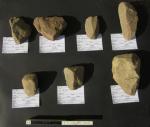Summary (English)
The excavations on the prehistoric mining site at Poggio Malinverno (Allumiere), on the Monti della Tolfa, are part of a research project run by the German Archaeological Institute, aimed at documenting Copper Age mining activities in central Italy.
The site of Poggio Malinverno – where the remains of an 18th century mine for the extraction of galena are visible – was chosen following a survey undertaken in 2010, during which numerous stone mallets were recovered, evidence of prehistoric farming. The 2012 excavations confirmed the presence of mining activity when an outcrop of copper ore was discovered in the south-western part of the mining area. Excavations here identified various fills of ancient pits and trenches, of the type seen in prehistoric surface mines. A possible mining shaft was also recorded, with a fill of dark earth containing several fragments of brown impasto pottery pre-dating the proto-historic period.
The 2013 excavations produced new dating evidence for the site. Proto-Villanovan and Etruscan burials came to light in the area where it is thought a settlement existed, at a distance of only about 50 m from the vein of ore. These remains are evidence for the existence of burials attributable to the Final Bronze Age (ca. 11th-10th and 6th cent. B.C.). The burials did not appear to have any direct relationship with the mining activity.
As the Final Bronze Age tomb was found overlying the levels of dumped mining waste, it provides a Terminus_ ante quem for the mining activity. Although it is not possible to give a precise date for the stone mallets at the moment, they very probably pre-date the late Bronze Age.
- Claudio Giardino - Università del Salento (Lecce)
- Daniel Steiniger - Istituto Archeologico Germanico, Roma
Director
Team
Research Body
Funding Body
- Istituto Archeologico Germanico (DAI) - Roma






![Download [PDF]](/excavation/skins/fasti/images/results/download_sml.png)